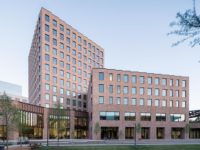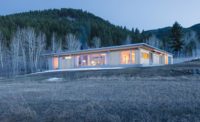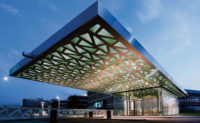An Office Complex by Barkow Leibinger Eases the Residential/Infrastructural Divide
Berlin

Architects & Firms
Referring to the site of B:HUB, an imposing 980-foot-long by 140-foot-high office complex skirting the S-Bahn in Berlin’s Friedrichshain district, architect Frank Barkow says, “We call this an infrastructural infill condition. It’s a site typology that keeps coming up in our work.” Similar overlooked properties scattered along this surface-rail system intrigue Barkow and partner Regine Leibinger for their development potential, particularly as local real-estate values rise, and they become more attractive for large-scale interventions that could enrich urban life (an interest the duo explored in design studios they conducted at Princeton University from 2016 to 2019.)

The linear structure stretches between the city’s gritty S-Bahn tracks and its verdant Stralau Peninsula, a residential area. Photo © Iwan Baan, click to enlarge.
Located south of the Ostkreuz train hub, the long, narrow structure nestles between the tracks and the urban vibe of city streets to the west, and the verdant Stralau Peninsula, a residential district bordered by the Rummelsburger Bay and the Spree River, to the east. In 2017, the client, developer Julian Streletzki, asked the architects’ firm, Barkow Leibinger Architects, to accommodate 90 start-up businesses in a building that could be rented in 4,300-square-foot units. According to Lukas Weder, lead principal on the project, the brief stipulated that, “each unit have a loggia, a roof terrace, or other outdoor area that would invite employees to spend evenings with views of Rummelsburger Bay, the Spree River, and the city center.” In addition, the huge project required acoustic insulation to buffer railroad noise—extremely loud due to antiquated tracks—as well as a smooth transition into the adjoining low-rise neighborhood. Finally, high groundwater on the site necessitated that the basement be partially raised above grade, resulting in an elevated ground floor.
To mitigate the building’s length, the design team developed a reinforced-concrete structure, partly poured in place and part prefabricated, folded into six irregular segments that gently project and recede, rising from six to 10 stories at its highest point. Setbacks starting at the sixth floor allow for generous terraces, while strips of balconies integrate with or protrude from the facades on the west and east elevations, respectively.
Easing the shift to the adjacent housing and leafy streets, a 20-foot-high base extends out along the eastern facade, where it faces a pedestrian walkway. Amenities and services located here include a supermarket, a public marketplace with small shops and restaurants for the local community, and a richly landscaped park on its roof, which can be accessed by a graceful stair from a small piazza and the promenade along Rummelsburger Bay.

1

2
B:HUB faces dwellings to its east, with a leafy second-floor extension—pierced by skylights (1 & 2)—and a stadium stair (3). Photos © Iwan Baan

3
To accommodate the intended myriad of small firms, B:HUB’s narrow 65-foot-deep plan features a continuous band down its center comprising seven circulation and services cores, while offices, with ceiling heights of 12 feet, line the perimeter. Exposed reinforced-concrete walls and visible mechanical and lighting hookups impart a relaxed, industrial character, bathed in daylight. For countering the din from the trains, a noise-abatement report was prepared, and the facade glazing was equipped with insulation values that respond to the level of sound emissions: more insulation on the west, which faces the trains, and less on the east. Sustainable strategies include the introduction of green roofs at various levels, rainwater retention via large infiltration basins, flexible layouts to enable diverse uses, and 700 parking spaces for bicycles, as compared to a mere 70 for automobiles.
For the exterior, Barkow and Leibinger turned to one of the firm’s favorite strategies—the “liminal facade,” an independent or “autonomous” architectural element, which gives the building its identity, regulates performance, and, most important, forms a complex spatial and material boundary that mediates between outside and inside. According to Barkow, this is “often an area where architects have some operational freedom.”
In selecting a distinct facade material, they explored the possibilities of custom-produced ceramic cladding. Collaborating with manufacturer NBK, the architects developed prototypes for up to 10 sculpted profiles—some with a narrow, scalloped surface, others wider—to clad the facade’s pilasters and balustrades. (By contrast, the cornices have pre-cast reinforced-concrete elements.) To achieve the desired color and stability, a special clay mixture was devised, along with a formula for the glazing to impart luster. A milky-white tone was chosen, says Barkow, because it would be the most effective with the fluted elements in terms of articulating light and shadow.

4
The ceramic-clad building (4) has daylit interiors with terraces along the upper level (5) and skylights over first-floor spaces like the café (6) beneath the second-floor terrace. Photos © Iwan Baan (4), Stefan Mueller (5 & 6)

5

6
The design team varied the fenestration and application of the tile to articulate the elevations in two ways: one, a relatively open grid that pauses the pilaster cladding at the cornice line, resulting in a flat, graphic surface; the other, a tighter grid with pilasters that continue beyond the cornice, producing greater depth, dimension, and plasticity. When glimpsed from the passing trains, B:HUB’s folded structure, alternating facades, and sculpted profiles enliven the perception of the megaform as if they were a brief abstract film speeding by.
During the advanced stages of planning, the client abandoned the start-up concept and agreed to two public-sector employers as tenants; they took up occupancy in 2021 and 2022, respectively. Post-pandemic, B:HUB impresses the tenants as a means to counter employees’ growing desire for remote work, by offering them a venue where they gladly spend time and enjoy a quality workplace. Due to their security concerns, however, the first floor now houses a cafeteria and fitness studio for building occupants exclusively, replacing the more neighborhood-focused marketplace approach, and the rooftop park one level above is closed to the public. Nonetheless, two areas remain accessible—the supermarket at the southeast corner and, on the northeast, the stair leading to the park, where locals gather and savor views of Rummelsburger Bay. “But this could change over time,” says Barkow. “All the pieces are in place. The programming can evolve.”
Click plan to enlarge

Click section to enlarge

Read about other office projects from the August 2023 issue.
Credits
Architect:
Barkow Leibinger — Frank Barkow, Regine Leibinger, partners; Lukas Weder, principal in charge; Andreas Hertel, project architect
Engineers:
HSP Ingenieure (structural); ibb Burrer & Deuring Ingenieurbüro (electrical); Rentschler und Riedesser; BWP-tec (hvac); Müller-BBM (building physics); FGS Berlin (civil)
Consultants:
BAL Bauplanungs und Steuerungs (construction management); SGP (project management); Licht Kunst Licht (lighting design); Topotek 1 (landscape architecture); CSD Ingenieure (sustainability); hhpberlin Ingenieure (fp)
Client:
SGI-Kynaststraße, a Streletzki Group company
Size:
689,000 square feet
Cost:
Withheld
Completion Date:
July 2022
Sources
Ceramic Facade:
NBK
Glass:
Schüco (facade)
Precast Concrete:
GBJ Geithner Betonmanufaktur Joachimsthal; BNB
Doors:
Hörmann (steel plate)







